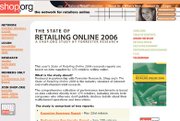Online Apparel Sales Keep Clicking Along
E-tailing is expected to exceed $200 billion this year, according to the recently released Shop.org/Forrester study “The 2006 State of Retailing Online.”
To be exact, the study projects a total of $211.4 billion in online sales, for a 20 percent growth over 2005—and an outstanding doubling over just two years. Of the nontravel- related segments, apparel, accessories and footwear should come out third, after computer hardware and software and autos and auto parts. Apparel is expected to remain the top category for the Holiday quarter, as it was last year.
The report goes on to observe that “as customers increasingly use the Internet to compare prices, find gift ideas and research products, retailers rely on their Web sites not only to sell merchandise, but also to increase sales at their stores.” This synergy of online presence and bricks-and-mortar stores has become the key to success for many new and established brands alike.
In an ongoing quest to create a truly multichannel environment, retailers are employing a variety of strategies. Some 79 percent have consistent pricing across channels, and 46 percent allow their customers to buy and redeem gift cards online and/or in bricks-andmortar stores. Additionally, a notable number of companies give customers the ability to accrue loyalty program points across channels (33 percent) and offer in-store product information online (26 percent).
“By encouraging different channels to work together, instead of in isolation, everybody wins,” said Scott Silverman, executive director of Shop.org, the Philadelphia-based e-commerce arm of the National Retail Federation. “Retailers have been focusing on integrating their Web sites and stores to better serve their customers, which is paying off for companies in the form of higher sales.”
Many retailers now recognize the importance an online channel plays in overall sales. In fact, retailers reported that 22 percent of off-line sales are influenced by a Web site, according to the study. And that number is likely to continue to grow. Web sites also can give retailers an opportunity to reach out to an entirely new customer base, as more than 38 percent of online customers are new to a company’s business.
Obviously, the security of customers’ personal information remains an advantage— or a barrier—for some online retailers. Many are increasing Web site security and beginning to offer a wider variety of payment methods to online shoppers. According to the report, 63 percent of retailers surveyed require card verification value codes at checkout. For payment, 25 percent of retailers accept private-label cards, 12 percent offer third-party e-mail payment options, 9 percent accept eChecks (which take a few days to clear), and 7 percent offer third-party credit accounts. Reasonable return and exchange policies—particularly with apparel— also continue to motivate customer loyalty.
The study concludes with an analysis of the future of online retailing, observing that retailers have spent much of the past year developing long-term forecasts, budgets and personnel plans. These new initiatives are expected to roll out over the next two years.
“Retailers spent the first decade of eCommerce scrambling to react to and learn about the Internet,” said Carrie Johnson, lead author of the report and research director, vice president, at Cambridge, Mass.–based Forrester Research (www.forrester.com).
“Companies are now able to take a step back and are busy planning strategies and prioritizing technology investment for the long term,” Johnson said. “As a result of these efforts, the next five to 10 years of online retail will be even more competitive and more innovative than in the past.”
For more information, or to purchase a report, go to www.shop.org/soro06.






















